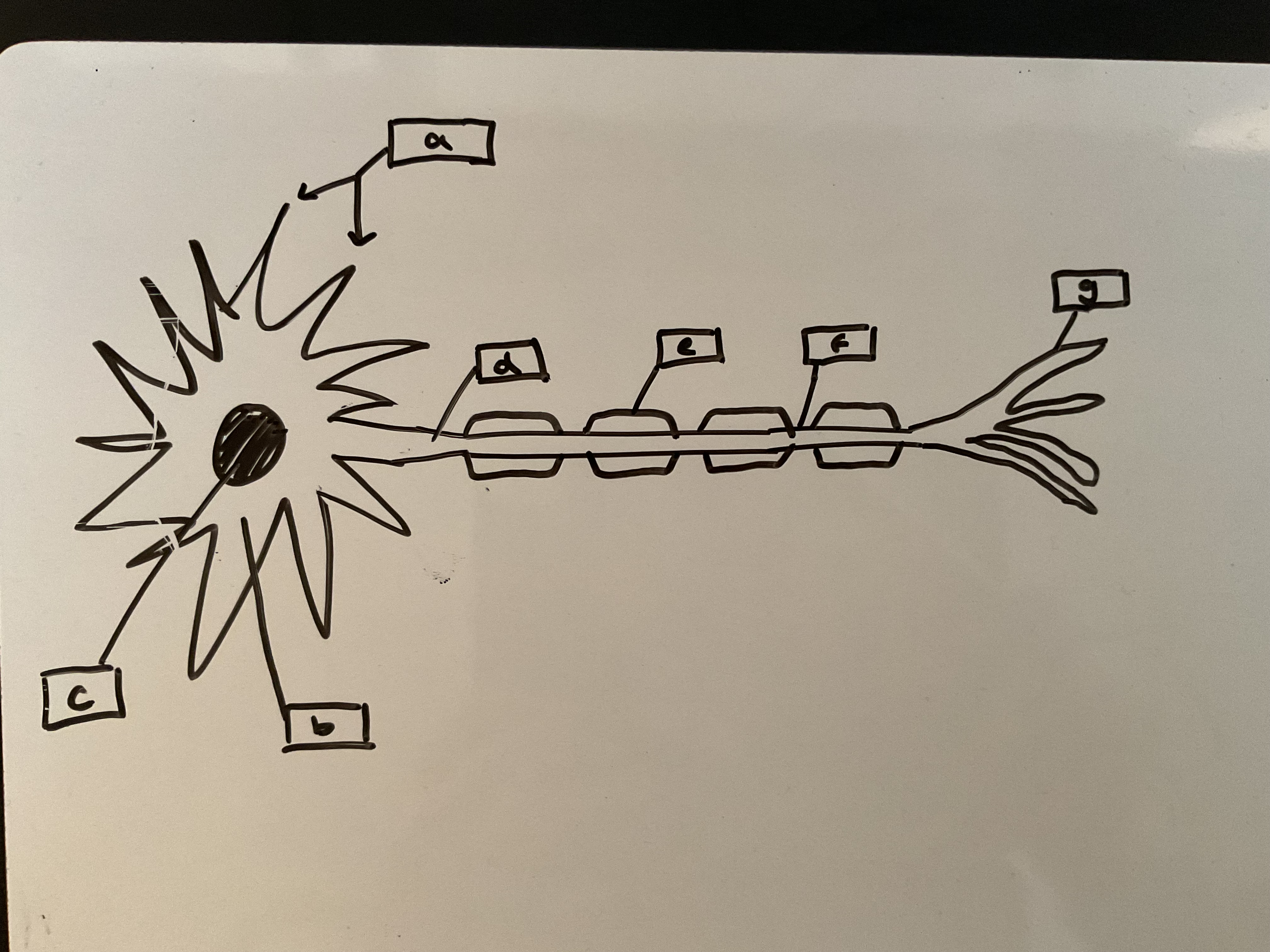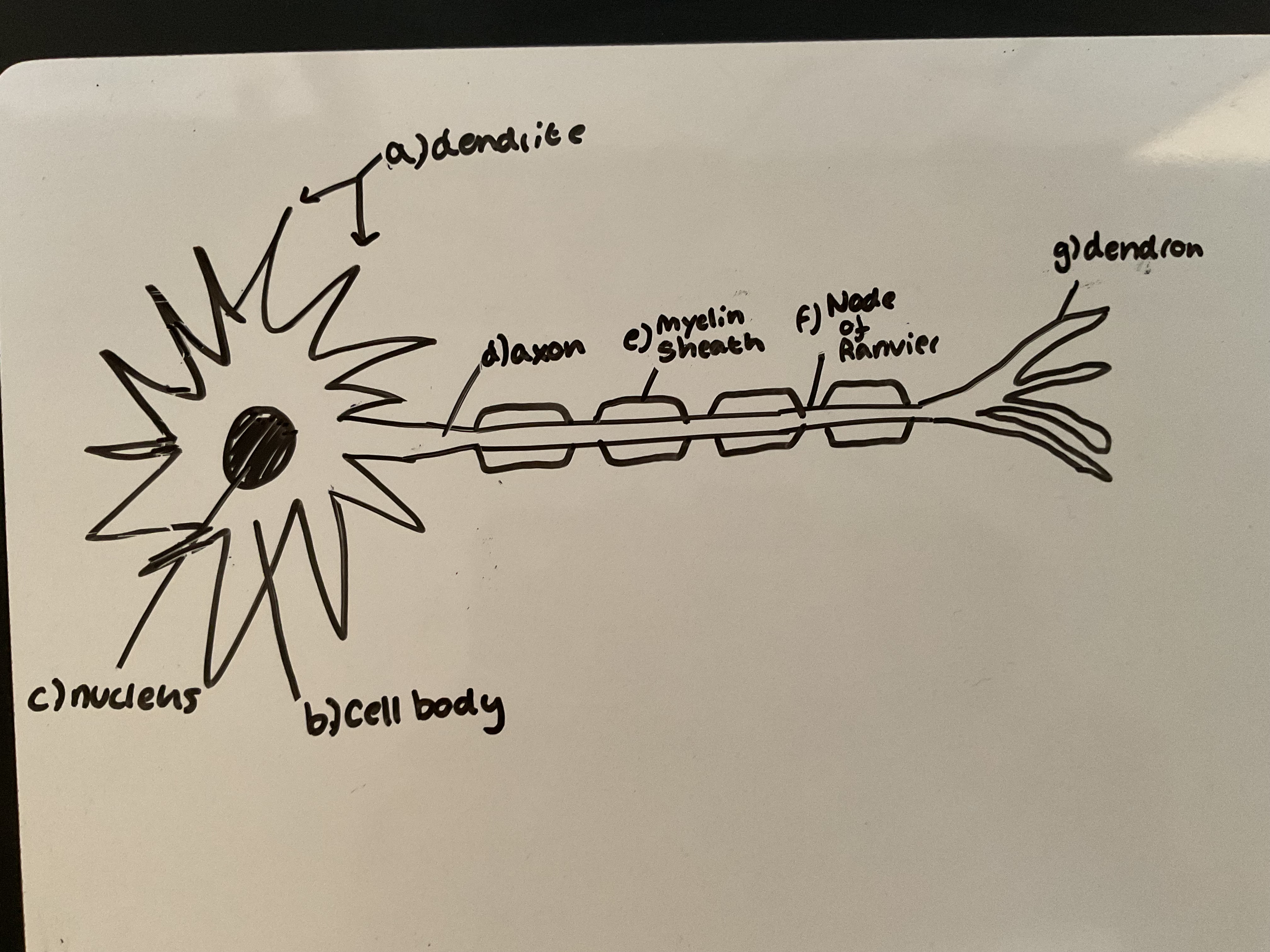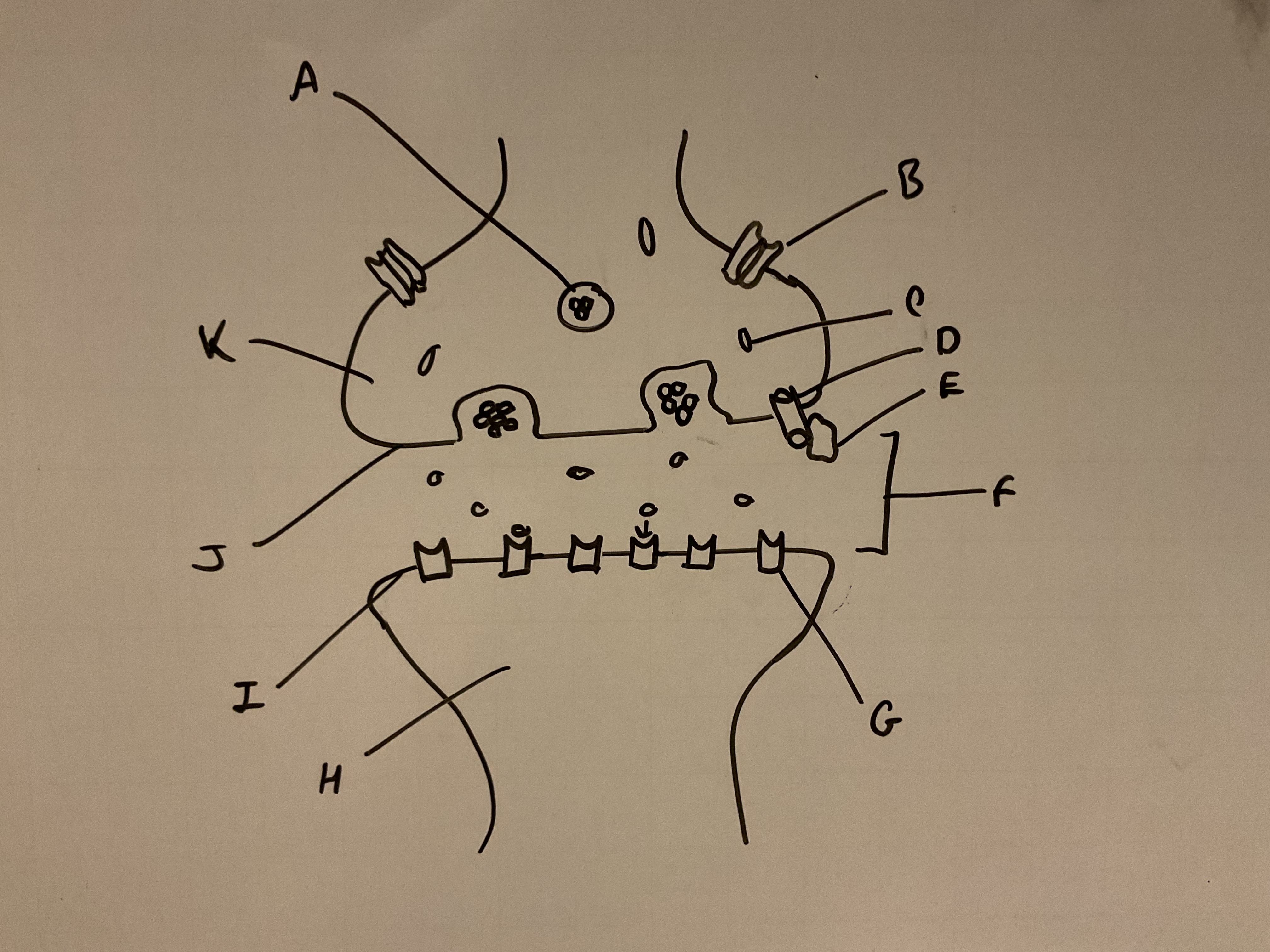Stimuli & Response, Reflex Arc, Nerve impulses, Synaptic Transmission, Receptors
1/43
There's no tags or description
Looks like no tags are added yet.
Name | Mastery | Learn | Test | Matching | Spaced |
|---|
No study sessions yet.
44 Terms
What does the central nervous system include
Brain and Spinal Cord
What does the peripheral nervous system include
Sensory System and
Motor System
Voluntary
Automatic
- Sympathetic
- Parasympathetic

Label the structure of this motor neuron

Where do sensory neurones carry impulses to and from
carry impulses from receptors to the intermediate neurone or the brain
Where do intermediate neurones carry impulses to and from
interpret impulses, connect sensory and motor
Where do motor neurones carry impulses to
carry impulses to the muscles and glands
Describe the first phase of the action potential - resting potential
Is an un-stimulated axon / nerve fibre i.e. the neurone is not firing (no nerve impulse)
Resting cells are (-) inside and (+) outside
The maintenance of a resting potential is an active process (i.e. ATP dependent) that is controlled by sodium-potassium pumps
3Na+ are pumped outside the axon and 2K+ pumped into the axon by active transport
Sodium voltage gated channels closed
Potassium voltage gated channels closed
Other potassium ion channels are open, the membrane is more permeable to potassium
Potassium diffuses out
This creates an electrochemical gradient whereby the cell interior is relatively negative compared to the extracellular environment (as there are more positively charged ions outside of the cell and more negatively charged ions inside the cell)
Polarised membrane of -70mv
Define membrane potential of an axon
Differences of charges across the plasma membrane
Define threshold level
voltage required to initiate Action Potential (-55mv)
What is the all or nothing principle
Neurons fire all maximally or none at all
Increasing the intensity of the stimuli above the critical threshold value will not produce an increased response
The intensity of the nerve impulse and speed of transmission remain the same.
How can we tell the difference between a strong and weak stimulus
Number of nerve impulses – stronger stimulus = more impulses.
Describe the process of depolarisation during an action potential
Depolarisation refers to a sudden change in membrane potential – usually from a (relatively) negative to positive internal charge
In response to a signal initiated at a dendrite, voltage gated sodium channels open within the membrane of the axon
As Na+ ions are more concentrated outside of the neuron, the opening of sodium channels causes a passive influx of sodium
The influx of sodium causes the membrane potential to become more positive
(+40mv) (depolarisation)This is the action potential. The more Na+ moving in causes more VGC to open causing more Na+ to move in – this is positive feedback and shown by the steep curve of the graph
Describe the process of repolarisation during an action potential
Repolarisation refers to the restoration of a membrane potential following depolarisation (i.e. restoring a negative internal charge)
Following an influx of sodium, potassium voltage gated ion channels open within the membrane of the axon. +40mv the voltage gated sodium channels close and the potassium voltage gated channels open.
As K+ ions are more concentrated inside the neuron, opening potassium channels causes a passive efflux of potassium
The efflux of potassium causes the membrane potential to return to a more negative internal differential (repolarisation)
Positive outside axon - Negative inside axon
What is tropism
Growth of a part of a plant in response to a directional stimulus
What does IAA do in plant roots vs shoots
It stimulates cell elongation in shoots
It inhibits cell elongation in roots
Describe the process of positive phototropism in plant shoots
Cells at the tip of the shoot produce IAA, which is then transported down the shoot.
Initially it is transported evenly throughout all regions as it begins moving down the shoot.
Light causes IAA to move from the light side to the shaded side of the shoot.
IAA causes elongation of shoot cells so more IAA on shaded side means that cells on shaded side elongate more.
Shaded side of shoot elongates faster than light side – shoot tip bends towards light
Describe the process of negative phototropism in plant roots
Cells in the root tip make IAA.
Initially it is transported evenly throughout the root as it moves down.
Light causes IAA to move to the shaded side of the root.
IAA causes inhibition of cell elongation of root cells.
Cells on shaded side will elongate less due to more IAA on shaded side.
Root tip bends away from the light.
What is the advantage of plants having a positive phototropic response in their shoots and negative phototrophic response in their roots?
Positive in shoots - increase photosynthesis
Negative in roots - root grow into ground towards nitrates and phosphates
Describe the process of positive gravitropism in roots
Cells at the tip of the root produce IAA, which is then transported along the root.
Initially it is transported evenly throughout all sides of the root.
Gravity causes IAA to move from the upper side to the lower side of the root.
IAA inhibits elongation of root cells so more IAA on lower side means that cells on this side elongate less than upper side.
ie greater elongation on upper side so root bends downwards towards gravity.
Describe the process of negative gravitropism in shoots
Cells at the tip of the shoot produce IAA, which is then transported along the shoot
Initially it is transported evenly throughout all sides of the shoot.
Gravity causes IAA to move from the upper side to the lower side of the shoot.
IAA stimulates elongation of shoot cells so more IAA on lower side means that cells on this side elongate more than upper side.
ie greater elongation on lower side so root bends upwards away from gravity.
What is hyperpolarisation
Membrane potential = -80mz
Voltage gated sodium channels close
Voltage gated potassium channels close slowly therefore excessive effluent of potassium
Positive outside, Negative inside
What is the refractory period
The period of time following a nerve impulse before the neuron is able to fire again
In a normal resting potential, sodium ions are predominantly outside the axon and potassium ions are inside
After depolarisation, this ionic distribution is reversed
Before a neuron can fire again, the resting potential must be restored via the action of the sodium-potassium pump
How is propagation of action potential carried out along a non-myelinated axon
Ion channels in the axon are voltage gated
Depolarisation at one axon segment triggers the opening of ion channels in next segment
Consequently, the action potential spreads along the axon as a wave of depolarisation
How is propagation of action potential carried out along a myelinated axon and why is this faster than in a non-myelinated axon
No action potential can occur in myelinated areas
They have to be initiated at the nodes of ranvier
Action potential jumps from node to node
Faster because action potential/depolarisation doesn’t travel entire length of axon
Explain the three factors that impact speed of a nerve impulse
Myelination
- Myelinated axons speed up nerve impulses because AP jumps from node to node instead of travelling entire axon
Axon diameter
- In larger axons, positive ions tend not to leak as much as narrow axons. This means the membrane potential is more easily maintained
Temperature
- Molecules move faster at higher temperatures, therefore rate of diffusion of ions will increase.
- Also, ATP from respiration required for sodium-potassium pump. Rate of respiration increases in higher temperatures because efficiency of respiration enzymes increases
What is the function of a synapse
A synapse conveys action potential between neurones

Label this synapse

What happens at the cholinergic synapse
An action potential arrives at presynaptic membrane V.G and calcium channels in the presynaptic neurone open.
Calcium ions enter the presynaptic neurone by facilitated diffusion causing synaptic vesicles to fuse with the presynaptic membrane realising acetylcholine into the synaptic cleft
Acetylcholine diffuses across the synaptic cleft and binds to specific neuroreceptor sites in the post synaptic membrane. These are chemically gated sodium ion channels
Sodium channels open and sodium ions diffuse into the poststynaptic membrane causing depolarisation which may initiate an action potential
Acetylcholinesterase breaks down acetylcholine into choline and ethanoic acid. The products diffuse back into the presynaptic neuron via to reuptake protein
Acetylcholine is re synthesised using ATP from the mitochondria and is stored in the synaptic vesicles. Sodium ion channels in post synaptic neurone close in absence of neurotransmitters
What feature of the synapse allows fro transmission to be unidirectional
Only neurotransmitters made in presynaptic neurone
Only receptors on post synaptic neurone
What is spatial summation
Several presynaptic neurones release to one postsynaptic neurone so enough neurotransmitters to exceed threshold value for an action potential
What is temporal summation
One presynaptic neurone releases neurtotransmitters many times in a short period to exceed the threshold value for action potential
What is a reflex
Reflexes are rapid, automatic responses that protect from harmful stimuli and therefore can help organisms to survive and avoid danger. They bypass the brain so the decision making process is removed
What is the reflex arc
Stimulus → Receptor → Sensory Neurone → Intermediate Neurone → Motor Neurone → Effector → Response
Why is the reflex arc important
Preventing tissue damage
Escaping predators
Balance and posture
Finding food
What is a receptor
Acts as a transducer and converts energy from one form to another. All receptors convert energy of the stimulus into a nerve impulse known as a generator potential
How does the Pacinian Corpuscle (Receptor) respond to changes in pressure
In its normal resting state, stretch mediated sodium channels are too narrow to allow diffusion of sodium ions
When pressure is applied to the corpuscle, the membrane is deformed and neurone becomes stretched
This widens and opens sodium channels allowing sodium ions to diffuse into the neurone
The influx of sodium depolarises the membrane and produces a generator potential
The generator potential can become an action potential which passes along other neurones and then to the CNS
How do rod cells in the eye provide high visual sensitivity but low visual acuity
Many rod cells attach to a single bipolar cell (sensory neurone) so there is a much greater chance that the threshold value will be exceeded as many impulses sent to the same neurone (retinal convergence/spatial summations)
Rods cells can therefore respond to light of very low intensity
However, this means that they can out distinguish between two separate sources of light/stimuli so they have low visual acuity
How do cone cells in the eye provide low visual sensitivity but high visual acuity
Each cone cell is attached to one bipolar cell/sensory neurone so threshold is often not exceed and will only respond to high light intensity
However this means that if two adjacent cells are stimulated, the brain will receive two separate impulses, giving cone cells good visual acuity
Why are cone cells concentrated in the fovea
Fovea receives highest intensity off light
Cone cells only respond to high intensities of light as they have low visual sensitivity
How do cone cells allow us to see in colour
Three different types of cone cells that respond to different wavelengths of light
- Red sensitive
- Blue sensitive
- Green sensitive
The colour perceived by the brain depends on which cone cells are stimulated
What is Taxis
Directional movement in response to a directional stimulus
What are the three main types of Taxis
Phototaxis
Gravitaxis
Chemotaxis
What is Kinesis
Response to a stimulus by changing the amount of activity; a non directional response to a non directional stimulus
Explain how a woodlouse would use kinesis to stay in damp environments where they won’t dry out
In dry environments, woodlice move quickly and do not turn much to increase their chances of moving out of that area
In the humid environment, they slow down and turn more to allow them to remain in the humid area